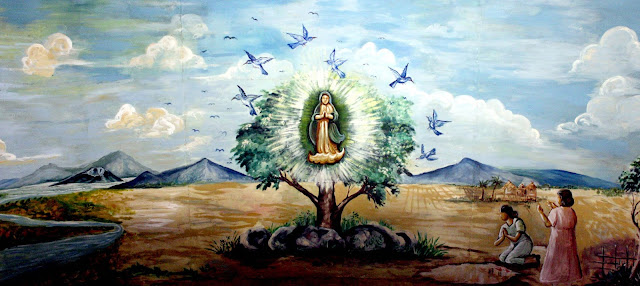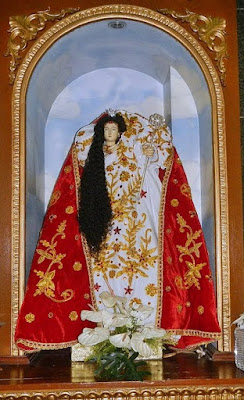Santa Maria Magdalena de Kawit: Kawit's Loving Paraluman
 |
| Santa Maria Magdalena de Kawit |
The people of Kawit is so attached to their Patroness that they call her as the "Paraluman" of the town ("Paraluman" means a woman who inspires a man or the people) or to her famous nickname "Sta. Nena"which is derived from "Magdalena".
The Image
 The miraculous image is a detailed wooden sculpture with carved hair, draped clothing and a pair of silver shoes, she holds a crucifix on her left hand and a jar or perfume on the right hand. Her detailed carved clothing is a mixture of pink, orange, gold and a hint of light green beneath the orange draping. A notable distinction of this image is that it has a "mark" in the middle of her forehead, it resembles a mole and no living local in Kawit knows why the statue has such a mark. Speculations suggests that this is the symbolic mark of Jesus's fingertip during the resurrection when he had appeared to Magdalene and said Noli me tangere (Touch me not). Some suggests that this mark is to clearly distinguish her identity from the Virgin Mary.
The miraculous image is a detailed wooden sculpture with carved hair, draped clothing and a pair of silver shoes, she holds a crucifix on her left hand and a jar or perfume on the right hand. Her detailed carved clothing is a mixture of pink, orange, gold and a hint of light green beneath the orange draping. A notable distinction of this image is that it has a "mark" in the middle of her forehead, it resembles a mole and no living local in Kawit knows why the statue has such a mark. Speculations suggests that this is the symbolic mark of Jesus's fingertip during the resurrection when he had appeared to Magdalene and said Noli me tangere (Touch me not). Some suggests that this mark is to clearly distinguish her identity from the Virgin Mary.This detailed wardrobe is not usually seen because, by tradition, the image is always clothed with a gown, usually red in color with gold embroideries and orange, yellow or golden cape. A long wig that reaches to the hem of the gown is also placed on top of her carved hair. Three yellow strips of ribbon (or sash) is pinned horizontally to her gown to secure the wig from being displaced, and at the bottom, a pocket catches the ends of her wig. Only the face and hands are repainted from time to time, and the rest of the image's original paint is untouched.
The Life of St. Mary Magdalene
 |
| Actual details of the image |
Mary Magdalene has long been regarded as a prostitute or sexually immoral in western Christianity, but this is not supported in the scriptures. It is believed she was a Jewish woman who lived among Gentiles, living as they did. The Gospels agree that Mary was originally a great sinner. Jesus cast seven demons out of her when he met her. After this, she told several women she associated with and these women also became followers.
 During Jesus' ministry, it is believed that Mary Magdalene followed him, part of a semi-permanent entourage who served Jesus and his Disciples. Mary likely watched the crucifixion from a distance along with the other women who followed Christ during His ministry. Mary was present when Christ rose from the dead, visiting his tomb to anoint his body only to find the stone rolled away and Christ, very much alive, sitting at the place they laid Him. She was the first witness to His resurrection.
During Jesus' ministry, it is believed that Mary Magdalene followed him, part of a semi-permanent entourage who served Jesus and his Disciples. Mary likely watched the crucifixion from a distance along with the other women who followed Christ during His ministry. Mary was present when Christ rose from the dead, visiting his tomb to anoint his body only to find the stone rolled away and Christ, very much alive, sitting at the place they laid Him. She was the first witness to His resurrection.After the death of Christ, Venerable Tradition holds that she remained among the early Christians. After fourteen years, she was allegedly put into a boat by Jews, along with several other saints of the early Church, and set adrift without sails or oars. The boat landed in southern France, where she spent the remaining years of her life living in solitude, in a cave. St. Mary Magdalene's feast day is July 22. She is the patroness of converts, repentant sinners, sexual temptation, pharmacists, tanners and women, and many other places and causes.
 |
| Sta. Maria Magdalena Parish in Kawit, Cavite |
The Jesuits first came to Kawit in 1624 to spread Christianity. The first wooden church was constructed in 1638 through the help of six Filipino families from the towns of Maragondon and Silang, Cavite. The town of Kawit, which was formerly known as Cavite Viejo during Spanish occupation, was frequented by Spanish marines, which slowly turned the town into a "red-light district".
To help solve the bad reputation of the place, Manila Archbishop Miguel Garcia Serrano (1618–1629) ordered the dedication of the Kawit Church to St. Mary Magdalene, who became the patroness of the town. With the growing devotion to Santa Maria Magdalena, the bad reputation of the place was completely wiped out.
 |
| Emilio Aguinaldo |
The First President of the Republic of the Philippines, General Emilio Aguinaldo, who hailed from Kawit, Cavite is the most famous Devotee of St. Mary Magdalene. Every time before he set out on his trip, he would pray before the Miraculous Image of St. Mary Magdalene. He even named his Movement "Magdalo" after Kawit's Patroness. It is no wonder that Sta.Maria Magdalena has also earned the unofficial title as the “Patron Saint of the Philippine Revolution.”
The Fiesta of the Patrona and her Karakol
 Her Feast day falls on July 21-22 and is the Major Pilgrimage Event. Devotees offer flowers and prayers before her Miraculous Image and is danced through the streets (Karakol) of Kawit by her Devotees. The month of May is also important to her devotees where the Karakol to Sta. Maria Magdalena is done everyday for the whole month and the Karakol will go around the area of Kawit as if she visit their homes and bless them.
Her Feast day falls on July 21-22 and is the Major Pilgrimage Event. Devotees offer flowers and prayers before her Miraculous Image and is danced through the streets (Karakol) of Kawit by her Devotees. The month of May is also important to her devotees where the Karakol to Sta. Maria Magdalena is done everyday for the whole month and the Karakol will go around the area of Kawit as if she visit their homes and bless them.On the eve of the fiesta, at 7 in the morning, the caracol tradition of bringing the image out in her flower-trimmed anda to make the rounds of the town begins. The anda bearers and the thousands of pilgrim-followers dance their way from Binakayan to Alapan, while prayers are said and favors are requested. Fandango is the traditional dance step used to convey the image from town to town. Groups of devotees called “Maginoos” and “Ginangs” dressed in their finery are at the tail-end.

Many Miracles of St. Mary Magdalene have been reported throughout Kawit and the Neighbouring Towns and Cities, and people from different Parts of Cavite, Manila, and Luzon today make pilgrimage to her shrine to pray through her intercession for the healing of the sick, for good fortune, good health, long living etc. The devotion to Sta. Maria Magdalena knows no bound, through periods of strife, struggle and present-day prosperity and she even became an inspiration for the movement of Philippine Independence.





Ang Karakol ng Mahal na Patrona ay tinatatawag na Sayaw "Kandirit" dahil sa paraan ng Pagsayaw sa Andas nito na Umiigkas o iniiaangat ang mga paa sa paraang Pasayaw.
ReplyDelete